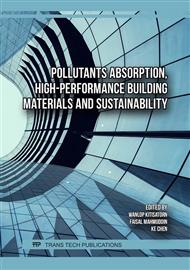[1]
D. Patah and A. Dasar, "The Impact of using Rice Husks Ash, Seawater and Sea Sand on Corrosion of Reinforcing Bars in Concrete," Journal of the Civil Engineering Forum, pp.251-262, September, 2023.
DOI: 10.22146/jcef.6016
Google Scholar
[2]
D. Patah, A. Dasar, Apriansyah and M. A. Caronge, "Patah, D., Dasar, A., Apriansyah, & Caronge, M. A. (2023, July). Strength Development of Seawater Mixed and Cured Concrete with Various Replacement Ratios of Fly Ash," Materials Science Forum, vol. 1091, pp.111-118, 2023.
DOI: 10.4028/p-1ckry6
Google Scholar
[3]
A. Dasar, D. Patah, H. Hamada, Y. Sagawa and D. Yamamoto, "Applicability of seawater as a mixing and curing agent in 4-year-old concrete," Construction and Building Materials, vol. 259, p.119692, 2020.
DOI: 10.1016/j.conbuildmat.2020.119692
Google Scholar
[4]
D. Patah, A. Dasar and A. Nurdin, "Durabilitas Baja Tulangan pada Beton Menggunakan Material Batu Gamping, Pasir Laut dan Air Laut dalam Campuran Beton," MEDIA KOMUNIKASI TEKNIK SIPIL, vol. 28, no. 1, pp.109-117, 2022.
DOI: 10.14710/mkts.v28i1.43380
Google Scholar
[5]
T. Nishida, N. Otsuki, H. Ohara, Z. M. Garba-Say and T. Nagata, "Some considerations for applicability of seawater as mixing water in concrete," Journal of Materials in Civil engineering, vol. 27, no. 7, p. B4014004, 2015.
DOI: 10.1061/(asce)mt.1943-5533.0001006
Google Scholar
[6]
H. Sharon and K. Reddy, "A review of solar energy driven desalination technologies," Renewable and Sustainable Energy Reviews, vol. 41, pp.1080-1118, 2015.
DOI: 10.1016/j.rser.2014.09.002
Google Scholar
[7]
Japan Concrete Institute, "Technical Committee on the Use of Sea Water in Concrete Committee Report: JCI-TC121A," JAPAN, 2014.
Google Scholar
[8]
JSCE, "JSCE Guidelines for Concrete: Standard Specification for Concrete Structure Materials and Construction," JAPAN, 2007.
Google Scholar
[9]
D. Patah and A. Dasar, "Strength Performance of Concrete Using Rice Husk Ash (RHA) as Supplementary Cementitious Material (SCM)," Journal of the Civil Engineering Forum, pp.261-276, September, 2022.
DOI: 10.22146/jcef.3488
Google Scholar
[10]
A. A. Awal and I. A. Shehu, "Performance evaluation of concrete containing high volume palm oil fuel ash exposed to elevated temperature," Construction and Building Materials, vol. 76, pp.214-220, 2015.
DOI: 10.1016/j.conbuildmat.2014.12.001
Google Scholar
[11]
N. O. Attoh-Okine and W. M. KIM RODDIS, "Uncertainties of asphalt layer thickness determination in flexible pavements-influence diagram approach," Civil Engineering Systems, vol. 15, no. 2, pp.107-124, 1998.
DOI: 10.1080/02630259808970233
Google Scholar
[12]
K. Gopalakrishnan and M. R. Thompson, "Simulated aircraft load testing and non-destructive evaluation of bituminous pavements," Civil Engineering and Environmental Systems, vol. 25, no. 3, pp.215-225, 2008.
DOI: 10.1080/10286600801919789
Google Scholar
[13]
D. A. Grivas and Y.-C. Shen, "A fuzzy set approach for pavement damage assessments," Civil Engineering Systems, vol. 8, no. 1, pp.37-47, 1991.
DOI: 10.1080/02630259108970604
Google Scholar
[14]
H. Hengl, W. Kluger-Eigl, R. Blab and J. Füssl, "The performance of paving block structures with mortar filled joints under temperature loading, accessed by means of numerical simulations," Road Materials and Pavement Design, vol. 19, no. 7, pp.1575-1594, 2018.
DOI: 10.1080/14680629.2017.1330221
Google Scholar
[15]
J.-H. Tay, "Ash from oil-palm waste as a concrete material," Journal of Materials in Civil engineering, vol. 2, no. 2, pp.94-105, 1990.
DOI: 10.1061/(asce)0899-1561(1990)2:2(94)
Google Scholar
[16]
J. -H. Tay and K. -Y. Show, "Use of ash derived from oil-palm waste incineration as a cement replacement material," Resources, conservation and recycling, vol. 13, no. 1, pp.27-36, 1995.
DOI: 10.1016/0921-3449(94)00012-t
Google Scholar
[17]
A. I. Bashar, U. J. Alengaram, M. Z. Jumaat and A. Islam, "The effect of variation of molarity of alkali activator and fine aggregate content on the compressive strength of the fly ash: palm oil fuel ash based geopolymer mortar," Advances in Materials Science and Engineering, 2014.
DOI: 10.1155/2014/245473
Google Scholar
[18]
Badan Standardisasi Nasional (BSN), SNI 03-0691-1989: Bata Beton (Paving Block), 1996.
Google Scholar
[19]
M. H. Ahmad, R. C. Omar, M. A. Malek, N. M. Noor and S. Thiruselvam, "Compressive strength of palm oil fuel ash concrete. In Proceedings of the international conference on construction and building technology," in In Proceedings of the international conference on construction and building, Kuala Lumpur, Malaysia, June, 2008.
Google Scholar
[20]
K. Muthusamy, N. Zamri, N. Ghazali, S. M. S. Mohsin and A. Kusbiantoro, "Compressive strength and density of oil palm shell lightweight aggregate concrete containing palm oil fuel ash under different curing regime," in Proceedings of 2015 International Conference on Innovations in Civil and Structural Engineering, June 2015.
DOI: 10.1016/j.proeng.2015.11.142
Google Scholar
[21]
S. Mayooran, S. Ragavan and N. Sathiparan, "Comparative study on open air burnt low-and high-carbon rice husk ash as partial cement replacement in cement block production," Journal of Building Engineering, vol. 13, pp.137-145, 2017.
DOI: 10.1016/j.jobe.2017.07.011
Google Scholar
[22]
D. M. Sadek, M. M. El-Attar and A. M. Ali, "Physico-mechanical and durability characteristics of concrete paving blocks incorporating cement kiln dust," Construction and Building Materials, vol. 157, pp.300-312, 2017.
DOI: 10.1016/j.conbuildmat.2017.09.107
Google Scholar
[23]
N. Chusilp, C. Jaturapitakkul and K. Kiattikomol, "Utilization of bagasse ash as a pozzolanic material in concrete," Construction and Building Materials, vol. 23, no. 11, pp.3352-3358, 2009.
DOI: 10.1016/j.conbuildmat.2009.06.030
Google Scholar
[24]
G. A. Habeeb and H. B. Mahmud, "Study on properties of rice husk ash and its use as cement replacement material," Materials research, vol. 13, pp.185-190, 2010.
DOI: 10.1590/s1516-14392010000200011
Google Scholar
[25]
A. S. Muntohar and M. E. Rahman, "Lightweight masonry block from oil palm kernel shell," Construction and Building Materials, vol. 54, pp.477-484, 2014.
DOI: 10.1016/j.conbuildmat.2013.12.087
Google Scholar
[26]
M. E. Rahman, A. L. Boon, A. S. Muntohar, M. N. H. Tanim and V. Pakrashi, "Performance of masonry blocks incorporating palm oil fuel ash," Journal of cleaner production, vol. 78, pp.195-201, 2014.
DOI: 10.1016/j.jclepro.2014.04.067
Google Scholar
[27]
V. Kodur, "Properties of concrete at elevated temperatures," International Scholarly Research Notices, 2014.
Google Scholar



